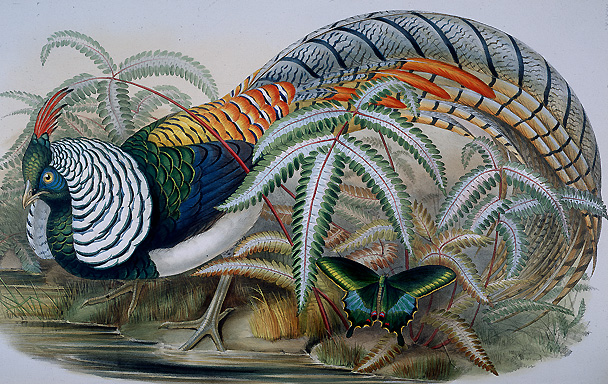Lady Amherst
Pheasant
Chrysolophus
amherstiae (Leadbeater)
 In
their native habitat, these birds may be found at the junction
of China, Tibet and Burma; in northwest Yunnan to altitudes of
15,000 feet, while in northwest Burma to 8,000 feet (Smythies
1986). The species was named in honor of Countess Lady Sarah Amherst
(1762-1838), wife of William Pitt Amherst, Governor General of
India from 1823-1828 (Gotch 1981). Lord Amherst was responsible
for sending the first specimen to London in 1828. The bird did
not survive the journey, but the ornithologist Leadbeater nevertheless
used the specimen for his official description in 1829. In July
1869, the first live specimens successfully reached London.
In
their native habitat, these birds may be found at the junction
of China, Tibet and Burma; in northwest Yunnan to altitudes of
15,000 feet, while in northwest Burma to 8,000 feet (Smythies
1986). The species was named in honor of Countess Lady Sarah Amherst
(1762-1838), wife of William Pitt Amherst, Governor General of
India from 1823-1828 (Gotch 1981). Lord Amherst was responsible
for sending the first specimen to London in 1828. The bird did
not survive the journey, but the ornithologist Leadbeater nevertheless
used the specimen for his official description in 1829. In July
1869, the first live specimens successfully reached London.
Good quality feathers from
the Amherst pheasant tail and head are essential materials for
the salmon fly tier. Lady Amherst Pheasant tails are similar in
shape to Golden Pheasant tails but in coloration they are black
and white instead of black and brown. Sections from tail feathers,
while not commonly used in British patterns, are fairly common
in Canadian and Norwegian patterns. Patterns using these fiber
sections include Black Dog, Lady Amherst, Bonne Bouche, Champion,
Hempseed and Silver Grey.
The head of the Lady Amherst
Pheasant contains valuable crests (toppings) and ruff feathers
(tippets). Toppings are crimson and have been called for in William
Blacker's Spirit Fly (1855), and tippets are used in flies such
as the Black Silk and Evening Star. Another use for Lady Amherst
pheasant tail fibers is for horns of salmon flies. For example,
Kelson (1895) uses Amherst horns in the Abinger. The senior author
of this book frequently uses the tail fibers for horns in his
artistic salmon flies.
If you want to know more
about the Lady Amherst pheasant and other birds related to our
fly tying heritage, we suggest you order Rare
and Unusual Fly Tying Materials: A Natural History.
RETURN
TO FLY
 In
their native habitat, these birds may be found at the junction
of China, Tibet and Burma; in northwest Yunnan to altitudes of
15,000 feet, while in northwest Burma to 8,000 feet (Smythies
1986). The species was named in honor of Countess Lady Sarah Amherst
(1762-1838), wife of William Pitt Amherst, Governor General of
India from 1823-1828 (Gotch 1981). Lord Amherst was responsible
for sending the first specimen to London in 1828. The bird did
not survive the journey, but the ornithologist Leadbeater nevertheless
used the specimen for his official description in 1829. In July
1869, the first live specimens successfully reached London.
In
their native habitat, these birds may be found at the junction
of China, Tibet and Burma; in northwest Yunnan to altitudes of
15,000 feet, while in northwest Burma to 8,000 feet (Smythies
1986). The species was named in honor of Countess Lady Sarah Amherst
(1762-1838), wife of William Pitt Amherst, Governor General of
India from 1823-1828 (Gotch 1981). Lord Amherst was responsible
for sending the first specimen to London in 1828. The bird did
not survive the journey, but the ornithologist Leadbeater nevertheless
used the specimen for his official description in 1829. In July
1869, the first live specimens successfully reached London.